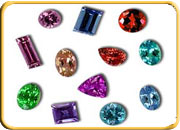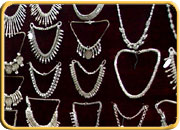Gems and Jewelry of Rajasthan

Rajasthan,
men and women traditionally wore necklaces, armlets, anklets, earrings and rings.
With the advent of the Mughal Empire, Rajasthan became a major centre for production
of the finest kind of jewellery. It was a true blend of the Mughal with the
Rajasthani craftsmanship. The Mughals brought sophisticated design & technical
know-how of the Persians with them.
Thewa pendant
The common link was the inherently decorative nature of the Muslim and Hindu
Art. The synthesis of the two cultures resulted in a period of grandeur and
brilliance that dazzlel the eyes of foreigners and has passed into legend.
Rajasthan, men and women traditionally wore necklaces, armlets, anklets, earrings
and rings. With the advent of the Mughal Empire, Rajasthan became a major centre
for production of the finest kind of jewellery. It was a true blend of the Mughal
with the Rajasthani craftsmanship. The Mughals brought sophisticated design
& technical know-how of the Persians with them. The common link was the
inherently decorative nature of the Muslim and Hindu Art. The synthesis of the
two cultures resulted in a period of grandeur and brilliance that dazzlel the
eyes of foreigners and has passed into legend.
Making of bangles
The jewellers of Rajasthan specialised in the setting of precious stories into
gold and the enamelling of gold. Jaipur, and to some extent Alwar, emerged as
the enamelling centres par excellence in the eighteenth and nineteenth century.
Enamelling was introduced by Maharaja Man Singh who had cordial relations with
Akbar. The enamelled gold staff of the Maharaja is unsurpassed even today for
its brilliant colours.
For enamelling, the piece to be worked on is fixed on a stick of lac and delicate
designs of flowers, birds and fishes etched on it.
A wall is made to hold the colours, while engravings are made in the grooves
to heighten the interplay of the transparent shades, thus enhancing the beauty
of the jewel. The surface is fully burnished by agate; then the enamel colours
are filled in painstakingly as in a miniature painting. The article is then
justify in the oven on a mica plate to keep it off the fire.Colours are applied
in order of their hardness; those requiring more heat first, those requiring
less, later.
Bejewelled tribal belle
When set, it is rubbed gently with the file and cleaned with lemon or tamarind.
The craftsmen in Jaipur are believed to have originally come from Lahore. In
Jaipur the traditional Mughal colours of red, green and white are most commonly
used in enamelling.
A quintessentially Indian technique and a speciality of Rajasthan is the setting
of stones by means of Kundan, the jewellery in which stones are set, is rarely
solid gold, it has a core of lac, a natural resin. The pieces which make up
the finished object are first shaped by specialised craftsmen (and soldered
together if the shape is complicated) and justify in separate hollow halves.
Holes are cut for the stones, any engraving or chasing is carried out, and the
pieces are enamelled. When the stones are to be set, lac is inserted in the
back, and is then visible in the front through the holes.
 Highly
refined gold, the kundan, is then used to cover the lac and the stone is pushed
into the kundan.
Highly
refined gold, the kundan, is then used to cover the lac and the stone is pushed
into the kundan.
More kundan is applied around the edges to strengthen the setting and give it
a neat appearance. This was the only form of setting for stones in gold until
claw settings were introduced under the influence of western jewellery in the
nineteenth century.
More than one craftsman was often involved in the making of a single piece of
jewellery. The chiterias made the design, the ghaarias the engraving, the meenakari
as the enameller and the sunar was the goldsmith. These craftsmen received patronage
from the nobles and the kings, and therefore, they did not have to compromise
their art for the sake of popular taste.
More details on Gems and
Jewelry of Rajasthan
Select a holiday
with us
 Rajasthan,
men and women traditionally wore necklaces, armlets, anklets, earrings and rings.
With the advent of the Mughal Empire, Rajasthan became a major centre for production
of the finest kind of jewellery. It was a true blend of the Mughal with the
Rajasthani craftsmanship. The Mughals brought sophisticated design & technical
know-how of the Persians with them.
Rajasthan,
men and women traditionally wore necklaces, armlets, anklets, earrings and rings.
With the advent of the Mughal Empire, Rajasthan became a major centre for production
of the finest kind of jewellery. It was a true blend of the Mughal with the
Rajasthani craftsmanship. The Mughals brought sophisticated design & technical
know-how of the Persians with them.  Highly
refined gold, the kundan, is then used to cover the lac and the stone is pushed
into the kundan.
Highly
refined gold, the kundan, is then used to cover the lac and the stone is pushed
into the kundan.